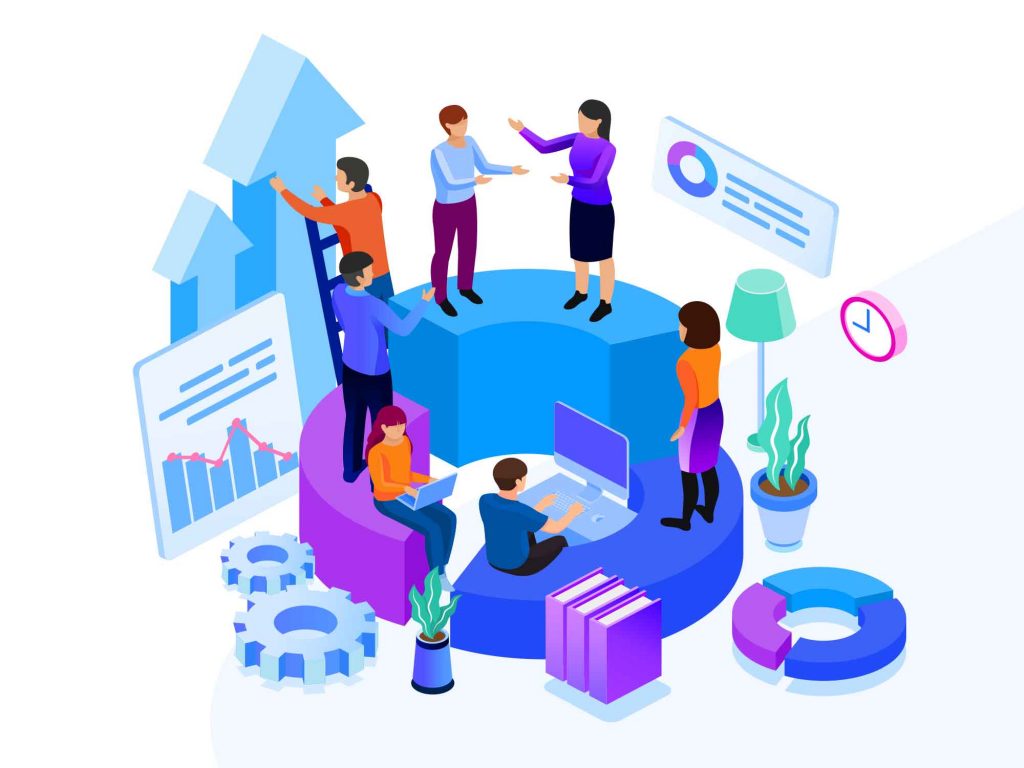Approximately 75% of the employees reported that they consider collaboration and teamwork important. Teamwork is the joint effort of a group of at least two or more members to achieve a common goal or complete a task in the most effective and efficient way.
Two heads are better than one!
Effective teamwork
Features that an effective teamwork should have:
- Team building from the right members
- Reaching the Common Purpose, Vision and Mission
- Strong Team Communication and Synergy
- A sense of belonging
- Joint Success
- Sharing of Authority and Responsibility
- Innovation and Creativity
- Team spirit
Teamwork dynamics
Teamwork dynamics allow the team to finish and deliver the product. Teams must basically meet the following dynamics:
- Open communication to avoid conflicts.
- Effective coordination to avoid confusion and crossing borders.
- Efficient cooperation to complete tasks on time and produce necessary results, especially in the form of workload sharing.
- High levels of interdependence to ensure high levels of trust, risk taking and performance.
While teamwork processes can vary from team to team, there are three processes that are common. At the beginning of building a team (or reshaping a team’s efforts), a transition process takes place. Once the team has set strategic goals, it can begin to move operationally towards the completion of those goals. The final team process is the process of improving team dynamics for interpersonal efficiency or individual productivity and success.
- The transition process is the stage where a team is formed. At this stage, mission analysis, goal setting and strategy formulation activities are carried out.
- Action processes include the stage at which a team performs its work. This process includes monitoring milestones and goals, monitoring systems, coordination, team monitoring and support activities.
- Interpersonal processes include activities that occur during both transition and action processes. Conflict management, motivation and trust building, and impact management activities are carried out to improve interpersonal processes.
Teamwork performance often improves when a team goes through these processes, as processes like this improve coordination and communication among team members, thereby increasing teamwork and collaboration. Teamwork and individual performance can be improved through specific training aimed at individual team members and the team as a whole.
Advantages & Disadvantages
Advantages of teamwork
- It enables problems to be solved faster and more effectively.
- Having healthy competition among team members affects the team in a good way.
- Increased time worked together increases the level of commitment of the team and can improve relationships by avoiding unnecessary conflicts.
- Sharing the individual qualifications of team members together with teamwork increases the knowledge and skills of the members.
- Working collaboratively can increase motivation within a team due to increased accountability for individual performance.
- Teams can break up a large project into smaller tasks. Collaboration can achieve more in less time.
Disadvantages of teamwork
- Some personalities tend to dominate the conversation.
- Teams may divide labor unequally in some cases.
- Teamwork may encounter scheduling conflicts.
- Some people may feel that their contribution is undesirable.
- It creates more competition in the workplace.
- Teams can create resource loss with their activities.
- You may not get the feedback you want from some people.
- Some people work better individually than in a team setting.
- There may be organizational challenges that need to be managed.
Overall, teamwork can lead to better decisions, products or services. The effectiveness of teamwork depends on six components of collaboration among team members: communication, coordination, balance of member contributions, mutual support, effort, and cohesion. To solve the disadvantages of teamwork, organizational approaches such as having people with similar working styles and programs in the same team, assigning people a role in the team, non-work activities to develop team synergy, and trainings to improve teamwork can be applied.
References
1. [2021], 2. (2021). 24+ Mesmerizing Workplace Collaboration Statistics [2021]. Retrieved 26 December 2021, from https://goremotely.net/blog/workplace-collaboration/
2. Defining Teams and Teamwork | Boundless Management. (2021). Retrieved 22 December 2021, from https://courses.lumenlearning.com/boundless-management/chapter/defining-teams-and-teamwork/
3. Sayfa, A., Çalışması, T., & Nedir?, T. (2019). Takım Çalışması Nedir? | IIENSTITU. Retrieved 24 December 2021, from https://www.iienstitu.com/blog/takim-calismasi-nedir
4. BECERİKLİ, Y. (2013). Takım çalışmaları ve verimlilik ilişkisi: Karar alma süreçlerinin etkinlik kazanmasında liderin rolü. Verimlilik Dergisi, (3), 93-116. Retrieved from https://dergipark.org.tr/tr/pub/verimlilik/issue/21764/233940
5. Gaille, L. (2020). 18 Biggest Advantages and Disadvantages of Teamwork. Retrieved 26 December 2021, from https://vittana.org/18-biggest-advantages-and-disadvantages-of-teamwork


